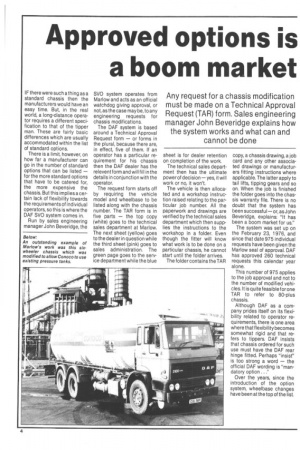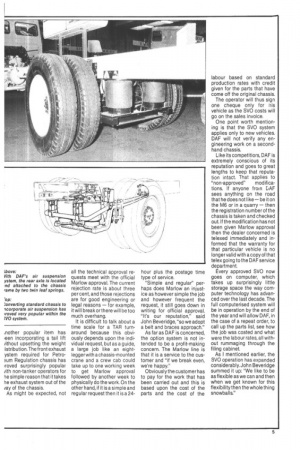Approved options is a boom market
Page 32

Page 33

If you've noticed an error in this article please click here to report it so we can fix it.
Any request for a chassis modification must be made on a Technical Approval Request (TAR) form. Sales engineering manager John Beveridge explains how the system works and what can and cannot be done
IF there were such a thing as a standard chassis then the manufacturers would have an easy time. But, in the real world, a long-distance operator requires a different specification to that of the tipper man. These are fairly basic differences which are usually accommodated within the list of standard options.
There is a limit, however, on how far a manufacturer can go in the number of standard options that can be listed — for the more standard options that have to be catered for, the more expensive the chassis. But this implies a certain lack of flexibility towards the requirements of individual operators, so this is where the DAF SVO system comes in.
Run by sales engineering manager John Beveridge, the SVO system operates from Marlow and acts as an official watchdog giving approval, or not, as the case may be, to any engineering requests for chassis modifications.
The DAF system is based around a Technical Approval Request form — or forms in the plural, because there are, in effect, five of them. If an operator has a particular requirement for his chassis then the DAF dealer has the relevent form and willful in the details in conjunction with the operator.
The request form starts off by requiring the vehicle model and wheelbase to be listed along with the chassis number. The TAR form is in five parts — the top copy (white) goes to the technical sales department at Marlow. The next sheet (yellow) goes to the dealer in question while the third sheet (pink) goes to sales administration. The green page goes to the service department while the blue sheet is for dealer retention on completion of the work.
The technical sales department then has the ultimate power of decision — yes, it will work or no, it won't.
The vehicle is then allocated and a workshop instruction raised relating to the particular job number. All the paperwork and drawings are verified by the technical sales department which then supplies the instructions to the workshop in a folder. Even though the fitter will know what work is to be done on a particular chassis, he cannot start until the folder arrives.
The folder contains the TAR copy, a chassis drawing, a job card and any other associated drawings or manufacturers fitting instructions where applicable. The latter apply to tail lifts, tipping gears and so on. When the job is finished the folder goes into the chassis warranty file. There is no doubt that the system has been successful — or, as John Beveridge, explains: "It has been a boom market for us."
The system was set up on the February 23, 1976, and since that date 975 individual requests have been given the Marlow seal of approval. DAF has approved 260 technical requests this calendar year alone.
This number of 975 applies to the job approval and not to the number of modified vehicles It is quite feasible for one TAR to refer to 80-plus chassis.
Although DAF as a company prides itself on its flexibility related to operator requirements, there is one area where that flexibility becomes somewhat rigid and that refers to tippers. DAF insists that chassis ordered for such use must have the DAF rear hinge fitted. Perhaps "insist" is too strong a word — the official DAF wording is "mandatory option ...'' Over the years, since the introduction of the option system, wheelbase changes have been at the top of the list ,nother popular item has leen incorporating a tail lift tithout upsetting the weight listribution. The front exhaust ystem required for PetroRam Regulation chassis has iroved surprisingly popular ,tith non-tanker operators for he simple reason that it takes he exhaust system out of the Jay of the chassis.
As might be expected, not all the technical approval requests meet with the official Marlow approval. The current rejection rate is about three per cent, and those rejections are for good engineering or legal reasons — for example, it will break or there will be too much overhang.
It is difficult to talk about a time scale for a TAR turnaround because this obviously depends upon the individual request, but as a guide, a large job like an eightlegger with a chassis-mounted crane and a crew cab could take up to one working week to get Marlow approval followed by another week to physically do the work. On the other hand, if it is a simple and regular request then it is a 24 hour plus the postage time type of service.
"Simple and regular" perhaps does Marlow an injustice as however simple the job and however frequent the request, it still goes down in writing for official approval. "It's our reputation," said John Beveridge, "so we adopt a belt and braces approach."
As far as DAF is concerned, the option system is not intended to be a profit-making concern. The Marlow line is that it is a service to the customer and "if we break even, we're happy."
Obviously the customer has to pay for the work that has been carried out and this is based upon the cost of the parts and the cost of the labour based on standard production rates with credit given for the parts that have come off the original chassis.
The operator will thus sign one cheque only for nis vehicle as the SVO costs will go on the sales invoice.
One point worth mentioning is that the SVO system applies only to new vehicles. DAF will not verify any engineering work on a secondhand chassis.
Like its competitiors, DAF is extremely conscious of its reputation and goes to great lengths to keep that reputation intact. That applies to
"non-approved" modifications. If anyone from DAF sees anything on the road that he does not like— be it on the M6 or in a quarry — then the registration number of the chassis is taken and checked out. If the modification has not been given Marlow approval then the dealer concerned is telexed immediately and informed that the warranty for that particular vehicle is no longer valid with a copy of that telex going to the DAF service department.
Every approved SVO now goes on computer, which takes up surprisingly little storage space the way computer technology has advanced over the last decade. The full computerised system will be in operation by the end of the year and will allow DAF, in the case of a repeat order, to call up the parts list, see how the job was costed and what were the labour rates, all without rummaging through the filing cabinet.
As I mentioned earlier, the SVO operation has expanded considerably. John Beveridge summed it up: "We like to be as flexible as we can and then when we get known for this flexibility then the whole thing snowballs."
































































